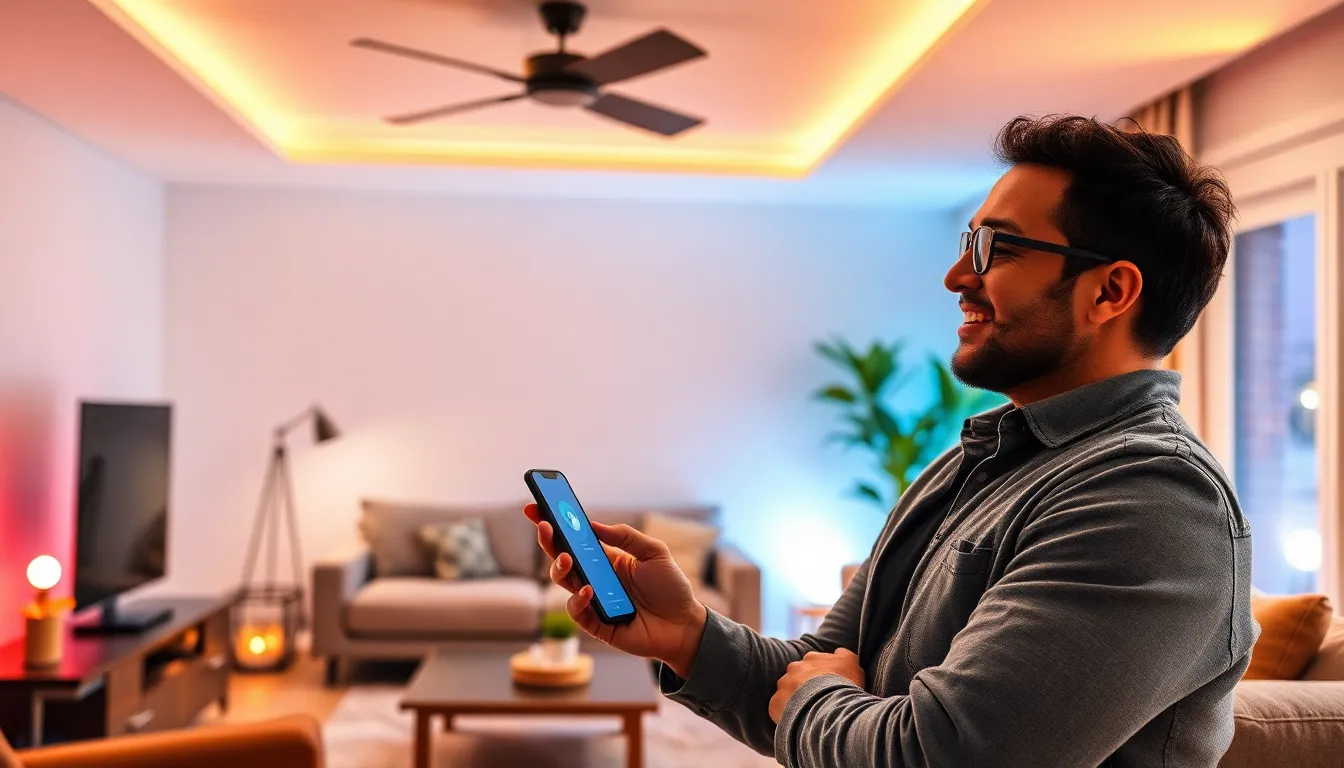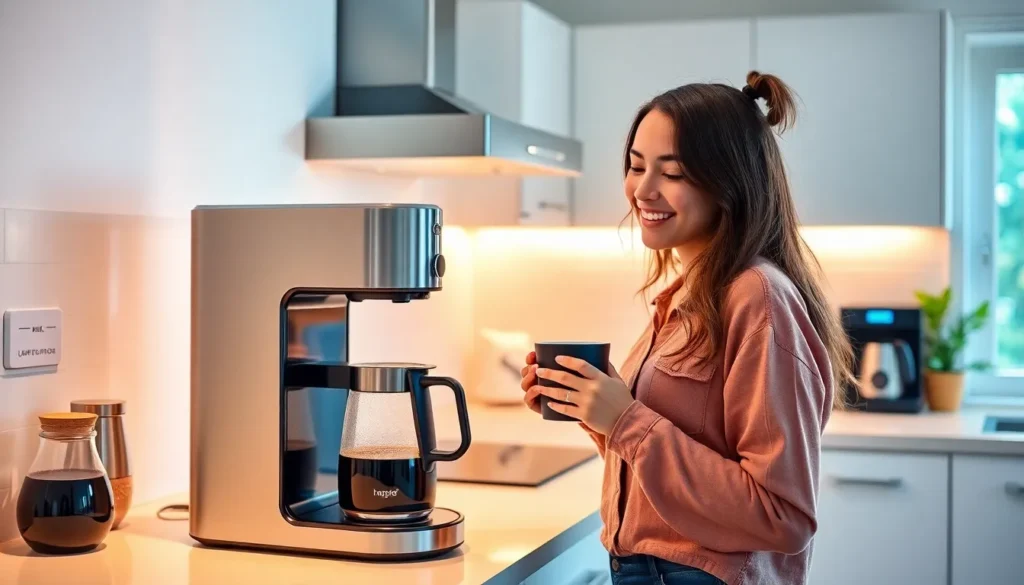Imagine walking into a room and having the lights greet you like an enthusiastic puppy. That’s the magic of automated lighting! Gone are the days of fumbling for switches in the dark or arguing over who left the lights on. With smart technology at your fingertips, lighting becomes a seamless part of everyday life, adjusting to your mood, schedule, and even the time of day.
Table of Contents
ToggleOverview of Automated Lighting
Automated lighting represents an innovative shift in how individuals interact with their environments. This technology adapts illumination to personal needs and preferences, simplifying the process of managing light in various settings.
Definition and Importance
Automated lighting refers to systems that control lighting automatically based on specific conditions or commands. Technologies like smart bulbs, sensors, and timers facilitate this process. Importance lies in energy efficiency, convenience, and enhanced ambiance. According to the U.S. Department of Energy, automated systems can save up to 30% on energy costs. As spaces become smarter, the integration of automated lighting plays a crucial role in sustainability and user comfort.
Key Components of Automated Lighting Systems
Key components making up automated lighting systems include smart bulbs, sensors, switches, and a hub for communication. Smart bulbs allow for remote control and scheduling through mobile apps. Sensors, both motion and ambient light types, adjust lighting based on presence or natural light levels. Smart switches enable control over entire circuits, enhancing flexibility. The hub acts as the central point connecting various elements, ensuring seamless communication. Collectively, these components create an efficient and user-friendly lighting experience.
Benefits of Automated Lighting

Automated lighting offers several advantages that enhance user experience and contribute to a sustainable environment.
Energy Efficiency
Energy efficiency ranks as one of the primary benefits of automated lighting. According to the U.S. Department of Energy, automated systems can save up to 30% on energy costs. Smart bulbs operate based on occupancy and daylight, ensuring lights only activate when needed. Sensors contribute by detecting motion, turning off lights in unoccupied spaces. This controlled approach not only cuts energy consumption but also reduces utility bills significantly. Users experience an eco-friendly lifestyle while enjoying cost savings.
Enhanced Convenience
Enhanced convenience defines the automated lighting experience. Users benefit from remote access through smartphones and voice control, making it easy to manage lighting from anywhere. Scheduling features allow lights to turn on and off automatically, aligning with personal routines. Instances of returning home to a well-lit environment have increased comfort and security. Quick adjustments based on mood or activity often create a welcoming atmosphere. Convenience plays a crucial role in making daily life smoother and more enjoyable.
Improved Security
Improved security stands as another major advantage of automated lighting. Users can simulate presence while away, deterring potential intruders with programmed lighting patterns. Motion sensors activate lights in response to movement, enhancing visibility at night. This proactive approach to safety provides peace of mind for homeowners and renters alike. Notifications alert users of unusual activity, empowering them to respond promptly. Enhanced security measures help create safer living environments.
Types of Automated Lighting Solutions
Automated lighting solutions encompass several innovative technologies that enhance convenience and energy efficiency. Understanding these types allows users to select the most suitable options for their needs.
Smart Bulbs
Smart bulbs enable remote control of lighting through mobile applications or voice commands. Users can adjust brightness and color to suit various moods and occasions. Energy-efficient LED options are widely available, contributing to lower electricity bills. These bulbs often integrate with smart home ecosystems, enhancing overall connectivity. Scheduling functions allow for automatic on/off times, promoting energy savings and security. Many smart bulbs also feature sensor capabilities, which adjust illumination based on natural light conditions.
Motion Sensors
Motion sensors automatically activate lighting when movement is detected, providing effective convenience and security. These devices enhance energy savings, as lights turn off after a specified period of inactivity. Some sensors integrate with smart home systems to adjust other devices based on occupancy, improving overall efficiency. Installing motion sensors in high-traffic areas like hallways and entrances increases safety and visibility. Configurable sensitivity settings allow users to customize how the sensors respond to different levels of movement.
Programmable Systems
Programmable systems include sophisticated setups for managing multiple lighting sources simultaneously. Users can customize schedules that align with their daily routines, preventing unnecessary energy consumption. Some systems utilize geographical location to adjust lighting based on user presence. Energy usage reports track savings over time, offering valuable insights into consumption patterns. These systems often connect with voice-activated assistants, further enhancing user control and convenience. Flexible programming options allow users to adapt settings for specific events or seasons with ease.
Challenges and Considerations
Automated lighting presents challenges that require careful thought and planning.
Installation and Setup
Installation often requires a basic understanding of electrical systems. Many users find professional assistance beneficial for optimal configuration and safety. Smart bulbs and sensors must align with existing fixtures, while compatibility with home networks affects overall performance. It’s crucial to follow manufacturer guidelines during setup to avoid potential complexities. Testing systems after installation ensures they function as intended, delivering an effective lighting experience.
Cost Analysis
Initial investment can be significant, particularly for comprehensive automation solutions. Costs vary based on system complexity and component quality. Smart bulbs may range from $10 to $50 each, while motion sensors typically cost between $20 and $100 per unit. When evaluating expenses, consider the long-term energy savings that can offset setup costs. Investing in energy-efficient products often contributes to lower utility bills, demonstrating a favorable return on investment.
Compatibility with Existing Systems
Compatibility represents a major consideration for homeowners planning upgrades. Older light fixtures or incompatible protocols can limit functionality or require additional changes. Systems using Wi-Fi, Zigbee, or Z-Wave present varying degrees of integration with existing infrastructure. Evaluating current home automation setups helps identify potential conflicts. Ensuring seamless interaction among devices increases the overall effectiveness of an automated lighting system.
Automated lighting represents a significant advancement in how individuals experience their living spaces. By seamlessly integrating technology with daily routines it enhances comfort and efficiency. The ability to adjust lighting based on personal preferences not only elevates ambiance but also promotes energy savings.
As more homeowners embrace this innovative approach they’re discovering the added benefits of security and convenience. With options ranging from smart bulbs to motion sensors the possibilities for customization are nearly endless.
Investing in automated lighting systems may require an upfront commitment but the long-term advantages make it a worthwhile consideration for anyone looking to improve their home environment.




